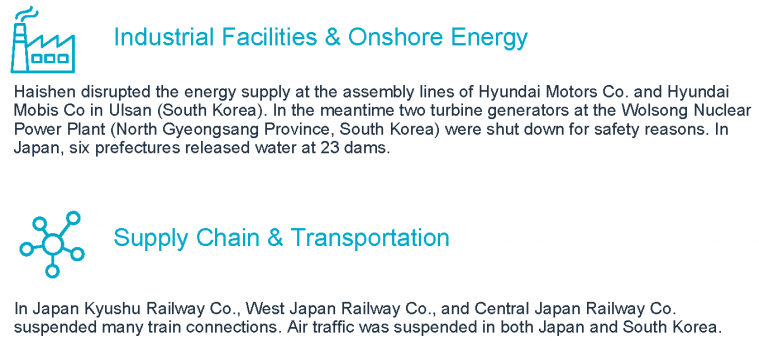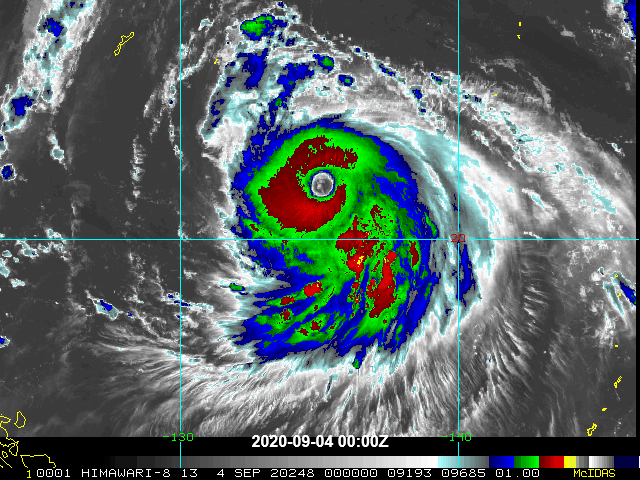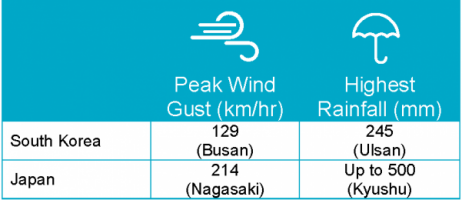
Typhoon Haishen made landfall near Ulsan, South Korea around 9 AM GMT+9 Monday, with 1-minute maximum sustained winds of around 155 km/hr (96 mph) prior to landfall, a category-2. About six hours before landfall, the storm brushed past Japan’s Kyushu Island. Haishen hit areas already affected by typhoon Maysak, and flood effects were further amplified by prior monsoon activity in the area. Extensive damage caused by wind, flooding, and landslide have been reported to property and infrastructure in both South Korea and Japan. The Typhoon Haishen CAT-i bulletin comprises the following sections
- Regional Impacts
- Notable Impacts by Sector
- Key Dates in the Timeline of Typhoon Haishen
- Physical Discussion of Typhoon Haishen
Regional Impacts

South Korea
The event caused at least two fatalities and five injuries, while one is still missing according to media reports. According to local authorities, two people were swept away by floodwaters in Samcheok (Gangwon Province) and Uljin (North Gyeongsang Province). Over 3,000 were ordered to move to government shelters, primarily in the South and North Gyeongsang Provinces. An evacuation advisory was also issued for residents in Goseong (Ganwon Province) due to flood risk. In the meantime authorities issued a typhoon alert for the island of Jeju (Gyeongsang Province) and areas of Gangwon and central provinces. A typhoon advisory was issued for the rest of the country.
Variable property damage has been reported, with over 100 houses destroyed due to flooding. Heavy rainfall also triggered landslides that destroyed a house near Busan, and various residential buildings in Geoje Island (South Gyeongsang Province). Another landslide disrupted traffic on the road connecting Busan to Changwon (South Gyeongsang Province). The typhoon also caused damage to port facilities and other structures.
Two turbine generators at the Wolsong Nuclear Power Plant were shut down for safety reasons after the typhoon disrupted the power supply. According to Korea Hydro & Nuclear Power Co., the owner of the plant, no radiation was leaked. Temporary power outages affected 37,644 households nationwide, according to the Central Disaster and Safety Countermeasures Headquarters. Blackouts were also reported in Busan, where the typhoon brought down trees and traffic signs. In Ulsan the assembly lines of Hyundai Motors Co. and Hyundai Mobis Co. were left without power.
Heavy rainfall and downed trees made roads impassable and caused traffic disruption in Ulsan and other coastal cities such as Busan, Gangneung and Sokcho (Gangwon Province). Various oceanfront roads were closed due to risk of seawater inundation caused by storm surge. Trains to and from Busan were halted, and according to Korea Airports Corp over 300 flights across 10 airports were canceled. Incheon port authorities also announced the suspension of passenger ferry services to nearby outlying islands. Winds and rough seas sank at least 80 fishing boats in the area.
Japan (Kyushu)
Haishen killed at least two and injured over 100, according to media reports. Most of the affected were in Kyushu, but some injured were also reported in the Kinki and Chugoku regions. Four people are missing in the village of Shiiba (Miyazaki Prefecture) after a landslide was triggered by heavy rainfall amounts of over 400 mm in a few hours. Authorities prompted over 22,000 members of the Self-Defense Forces for rescue operations.
Evacuation advisories were issued for nearly 4 million people, with evacuation centers operating at reduced capacity due to social distancing measures currently in place in the country. One evacuation center in the Miyazaki Prefecture had to stop accepting evacuees. The typhoon has cut power to over 475,000 homes, while torn rooftops have been reported in the Fukuoka and Kagoshima Prefectures. Many school, offices, department stores and shops in Kyushu remained closed. Most public transportation services were suspended in the affected prefectures. Kyushu Railway Co. halted its bullet and local train services, while West Japan Railway Co. suspended its bullet trains between Hakata and Hiroshima.
Also services provided by Central Japan Railway Co. were interrupted. Airlines cancelled more than 500 flights to and from Okinawa and various prefectures in Southern Japan. In the meantime telecommunications were disrupted. Users in Kyushu, Shikoku, and Chugoku reported service interruptions for mobile carriers NTT Docomo Inc., KDDI Corp., and SoftBank Corp. According to the Ministry of Land, Infrastructure, Transport and Tourism, six prefectures released water at 23 dams to avoid the risk of collapse or overflowing. The Japanese coastguard also suspended rescue operations for the 43 members of a livestock carrier that had capsized off the coast of Japan a few days earlier due to typhoon Maysak.
Notable Impacts by Sector

Key Dates in Timeline of Typhoon Haishen

Physical Discussion
Three key meteorological aspects are noteworthy to highlight: formation north of Guam, the rapid intensification in the Philippine Sea, and the partial decay of the storm before landfall.
1) Formation north of Guam: On August 29 a tropical disturbance northeast of Guam was detected by the Joint Typhoon Warning Center (JTWC). The feature was initially very disorganized, but progressively acquired energy while tracking southwest, leading the JTWC to issue a Tropical Cyclone Formation Alert. On September 1 the system was classified as a tropical depression, and then upgraded to a tropical storm. The Japan Meteorological Agency (JMA) gave it the international name of Haishen.
2) Rapid intensification (RI) in the Philippine Sea: On September 2 Haishen strengthened into a typhoon. The system then underwent a period of rapid intensification while moving northwest towards Japan and Korea. By September 4 Haishen had become a super typhoon, the first of the 2020 Pacific typhoon season. At peak strength the JTWC reported 1-minute sustained wind speeds of around 250 km/h (155 mph), a category-4 on the Saffir-Simpson Scale, with gusts of 305 km/hr (190 mph). In the meantime the Hong Kong Observatory reported 10-minute sustained wind speeds of 220 km/hr on September 5.

Satellite loop (infrared) ending 3 AM GMT September 4 showing Haishen at peak strength. Source: NOAA NESDIS.
3) Typhoon Haishen loses energy and makes landfall: As Haishen tracked further north-northwest, the progressively lower ocean heat content contributed to a weakening of the system. On September 6 just after 3 PM GMT+9 the system was moving north of Okinawa as a category-2, with 1-minute sustained winds of around 175 km/h (110 mph), and gusts to 204 km/h (127 mph). Haishen brushed the coast of Kyushu, Japan on Monday September 7 around 3 AM GMT+9, when the eye of the system passed over Nakadori Island (Nagasaki Prefecture). Haishen then made landfall in Ulsan, South Korea shortly before 9 AM GMT+9. Haishen carried 1-minute sustained winds of around 155 km/hr (96 mph) prior to landfall, a rapidly weakening category-2. The system was downgraded to tropical storm status as of 3 PM GMT +9 on September 7. After tracking through the Korean Peninsula, the system reentered the ocean near the city of Gangneung (Gongwong Province). Low sea surface temperatures caused the Haishen to lose energy before making a new landfall in North Korea near the city of Tanchon (South Hamgyong Province), around 7 PM GMT+9. Soon after, the system was reclassified by the JTWC as an extratropical storm while tracking toward the China-North Korea border.

Satellite loop (infrared) ending 00:30 GMT September 7 showing passage of Kyushu and Korean Peninsula landfall. Source: NOAA/NESDIS.
Peak Meteorological Statistics

Typhoon Haishen was the third typhoon to hit South Korea this year. The inland flood impacts were amplified as a result of recent passage of Typhoon Maysak, and also from prior heavy monsoon rainfall earlier in the year.
Sources: South China Morning Post, Channel News Asia, The Korea Times, The Korea Herald, NHK, The Mainichi, The Japan Times, The Watchers, Japan Meteorological Agency, Joint Typhoon Warning Center, NOAA, Weather Underground.